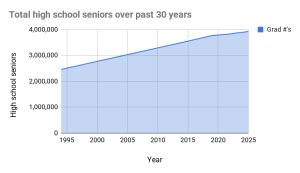Overcrowded bike racks force students to lock bikes elsewhere
December 7, 2016
In an new age of environmental and health awareness, bikes overcrowd the racks and students are forced to park creatively to trees fences, even other bikes.
Any student entering the building from the front or getting off the bus at the corner of Winnetka and Woodland can see the large number of bikes occupying every available inch of the bike racks.
“They are totally overcrowded, there is usually no space for me to lock my bike” said New Trier Student and regular bike rider Tyler Janszak, who has on occasion resorted to locking to a tree when there is no place else available.
It’s not difficult to see this issue as bikes regularly cover the railings of the amphitheater, or the steps of the Gaffney. As students become more aware of the health and environmental benefits of biking, ridership has increased and the school has yet to accommodate this rising tide.
A 2009 study from the U.S. Department of Transportation estimates that 11.9 percent of all trips in this country are done by walking or bicycling, a significant increase from just 9.5 percent in 2001.
In response to this wave of bike riders, New Trier Junior Casey Crowe said “There should be more bike racks to accommodate the bikers.”
Many students have alleged that bike racks were removed during the construction process.
However, Steve Linke Physical Plant Services Manager explained that of the twelve bike racks at Winnetka, some had been moved, but none removed.
In their various complaints about the bike parking situation, several students suggested that the bike racks at New Trier were not secure. Janszak said he felt his bike was “not really” secure while at school.
New Trier uses a grid style bike rack, which Dero, a popular manufacturer of bike parking options, says is one of its least secure models. In a publication from the company, the company says “Racks that cradle only the front wheel of the bike should be avoided” particularly for long term parking, such as would be required for a school day.
Teacher Colby Vargas felt differently. When asked if he felt his bike was secure while at school he said “Has been for the last twenty plus years.” Vargas’s claims are reinforced by Winnetka’s low crime rate, and the relative safety of the neighborhood.
Nonetheless, a perception of poor security could be enough to deter many students from biking to school.
A study by NACTO, the National Organization of City Transportation Officials, found that high quality bike infrastructure including but not limited to secure bike parking, is key to increasing bike ridership.
Linke says that PPS is well aware of the issue saying “We will be adding some bike racks on the north side of the school as part of the new addition” but that “At this time we are short on space because of the construction.”
With an increased understanding of the dangers of air pollution from cars, it is no surprise students are more eager than ever to bike to school.
Junior Ayanna Guillen summed up her experience biking to school saying “At the end of the day, people can barely get to their bikes.” This is an issue that affects students everyday, and in writing this article, there was no shortage of students who wished to lament their issues at the bike racks.
Whether it was that their bike has been locked to another persons by mistake, or that their bike was simply unretrievable due to the other bikes surrounding it, it is clear that there is a significant thirst for change in how New Trier treats its student, and teacher, bikers.
In a plea for bike riders to be made a priority Guillen said “It would be nice to have better bike racks because if New Trier can spend so much money on new big things, they should fix the simple things first.”











































